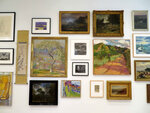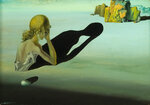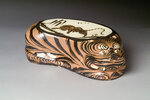



Two weeks ago, workers began tearing out drywall and dismantling cinderblock partitions in the lower level of MSU’s Broad Art Museum.
The lower-level renovation of a campus building — even a metal-clad, shark-like art museum designed by star architect Zaha Hadid — sounds routine.
This project is not routine. When it’s done, it will be a sanctuary for saints, Buddhas, Yoruba warriors and fertility gods, and that’s just for starters.
In early November, the Broad will open the Center for Object Research and Engagement, or CORE — a dedicated space where hundreds of pieces of art from the Broad’s permanent collection will go on view, including historic treasures inherited from its predecessor, the Kresge Art Museum.
The CORE brings a long, emotionally fraught saga full circle. When the Broad Museum opened in 2012, the Kresge Art Museum closed its doors forever, and some 7,500 works of art went into storage.
The Kresge collection spans a wide range of time and space, from magnificent Dutch old master paintings to art from Latin America, Africa and Asia; from a Freudian dreamscape by Salvador Dali to a hot pink Andy Warhol print; from ancient Roman mosaics to the urban fantasias of Detroit artist Tyree Guyton.
The Broad Museum’s emphasis on temporary exhibits of contemporary art, defined by the goals and tastes of mega-donors Eli and Edythe Broad, sent the whole enchilada into the freezer.
The abrupt transition frustrated supporters of Kresge and complicated the Broad Museum’s self-appointed mission — tough enough to begin with — of making the case for contemporary art in mid-Michigan.
For over a decade, the Broad’s “permanent collection,” which includes the former Kresge art and now numbers some 10,000 pieces, was used largely for research or taken upstairs, a piece at a time, to accessorize a contemporary art exhibit.
Under the Broad’s most recent director, Monica Ramirez-Montagut, that policy began to change. Before leaving the Broad in June 2022 to become the director of Long Island’s Parrish Art Museum, Ramirez-Montagut announced a plan to give the collection a permanent home.
Since then, the project has evolved under interim Broad director Stephen Bridges, adding educational and technological enhancements to the “open storage” space first envisioned.Bridges said the acronym CORE was chosen with a purpose.
“This collection is something we’ve known was beloved to this community since before this museum existed,” Bridges declared. “The collection is the core of who we are.”
Last week, Broad Museum deputy director Stephanie Kribs picked her way through scattered debris and equipment to check out the early work on the CORE.
She looked into an empty space, blocked by a half-demolished countertop.
“Oh — my office,” she sighed.
To make room for the project, Kribs is moving to the Student Services Building across the street.
“I can bring my laptop and work here anyway,” she quipped.
The CORE will be carved out of about 4,500 square feet of office space, a conference room, an existing exhibit space and other available nooks and crannies.
Bridges estimated that about 270 works from the Broad’s permanent collection will go on display there.
By comparison, former Kresge Art Museum director Susan Bandes estimated that about 300 to 400 objects were on display at a given time in the heyday of the Kresge, including “jam-packed cases of antiquities.”Paintings, drawings, prints and photographs will be displayed around the perimeter of the CORE on moveable screens, behind protective partitions of transparent polycarbonate and glass. The art will be displayed salon-style, in multiple layers, on 14-foot-high walls.
Among the former Kresge treasures that will go on display in the CORE is one of the collection’s crown jewels, “The Vision of St. Anthony,” by Spanish master Francisco de Zurburán. The dark, emotional portrait, dating from about 1630, was the first painting to enter the Kresge collection, in 1959. In the late 1980s, Bandes secured a grant to conserve the masterpiece — a job that took eight months — and made many trips to the Detroit Institute of Arts conservation lab to consult with the conservators.
“I got to know it inch by inch, not just on the surface, but through X-rays,” Bandes said. “I tell people the collection has a Zurburán and they say, ‘Really?’”
The Broad also inherited a rich set of Dutch oil paintings, including a magnificent seascape by Jan van Goyen, unseen by visitors since 2011, except for a few months in 2015.
“I bought great Dutch 17th-century paintings,” Bandes said drily. “I’m looking forward to seeing them in person.”
The Broad has loaned out another former Kresge treasure, Salvador Dali’s “Remorse, or Sphinx Embedded in the Sand,” to museums in Barcelona, Winnipeg and Vienna, as well as the Detroit Institute of Arts, but it hasn’t been on permanent display locally since the Kresge closed in 2011.
Bandes said she’ll wait until the CORE opens to give a full appraisal, but said it “will definitely be an improvement as far as seeing the collection.”
The CORE is expected to cost about $1.5 million, funded by a mix of private donations, including local donors and the Terra Foundation for American Art, and the Broad’s operating funds. Zaha Hadid Architects have approved the project, which will not affect the building’s shell or the shape of the above-ground galleries.
The Broad Museum’s original architect of record, Detroit-based Integrated Design Solutions, came back to draw up the plans. The same electrical contractor is back, too.
“They lived and breathed this building when it was being built,” Kribs said. “It’s like getting the team back together.”
To operate the space, the museum can draw upon existing endowments earmarked for collection care and upkeep.
The project was first conceived as an “open storage” space, a concept that has become widespread in the museum world.
Many museums, from the American Museum of Natural History to the University of Michigan Museum of Art, have recently built spaces where hundreds, or even thousands, of objects otherwise hidden in storage are made available for viewing and study.
But Bridges and the Broad Museum staff didn’t want to just stuff the basement with a jumble of objects.
“Of course, we want to pack in as much as we can, but we also want to create a space that allows people and class groups to gather and have a pleasurable experience,” he said.
A rich mix of information, from text in the room to smart phone tours and digital technology, will be available to guide visitors. At three “sensory stations,” visitors will be able to handle 3-D printed replicas of selected objects, adding a tactile dimension to experiencing the art.
One of the more intriguing objects in the collection is a 12th-century Chinese “tiger pillow,” an exquisitely painted ceramic headrest that was believed to imbue the sleeper with tiger-ish qualities while sleeping.
“The thought of resting your head on it — I really want to know what it feels like,” Bridges said. “Of course, we can’t do that, but technology has advanced to the point where we can re-create it as a facsimile.”
Bridges and his staff are working with MSU experts like archaeologist Jon Frey, a specialist in digital archaeology, and media design specialist Daniel Trego, to use technology to create 3-D scans and models of artworks and even convert flat works, like drawings and paintings, to contoured objects that make them accessible to visually impaired people.
The way Bridges described it, the CORE sounded more like a cool basement than a crammed cellar.
One loadbearing wall, made of architectural concrete, will have to stay, so Bridges and his staff have integrated it into the design. The wall will pop with ever-changing digital displays featuring artworks from the permanent collection that aren’t on view at a given time.
Bridges envisions the wall as a space for classes, other groups and curious museumgoers to gather, plan their visit to the Broad or just hang out.
“It will be very colorful, very playful,” Bridges said. “I’m very excited about it. It will be a very inviting space, a space that will provide greater access and comfort, a space that will speak to people of all ages.”
The CORE will give the Broad’s permanent collection its biggest showcase in over a decade, but it’s a far cry from a grand vision that seemed within reach for the Kresge Art Museum 20 years ago.
Elinor Holbrook was the president of the Kresge’s passionate and close-knit support group, Friends of Kresge.Holbrook is a fervent supporter of the Broad Museum. She praised its recent pivot toward community outreach and exhibits with local ties, but she wasn’t pleased with the way the university handled the transition a decade ago.
“Any strong feelings I had at the time were over the handoff,” she said. “It was so inartful. It was just brutal for everybody.”
In 2003, a volunteer support group unveiled dramatic plans to quadruple the Kresge, adding 32,000 square feet of galleries, using privately donated funds, with the goal of doing justice to collection, then housed in a small gallery inside an academic building on the Red Cedar River in mid-campus.
“If the exhibit can be faulted, it’s for an extra-artistic reason — the inadequacy of the exhibition galleries,” art critic Roger Green said in 2003. “The burgeoning art collection deserves a proper home.”
Two Kresge docents, David and Ruth Greenbaum, spearheaded a support group for the Kresge, Better Art Museum, raising thousands of dollars with a labor-intensive, all-volunteer barrage of grass-roots fundraisers, from bake sales to art auctions to candlelit dinners in MSU’s Horticultural Gardens.
The $11 million project envisioned huge walls for figurative expressionist canvases (a Kresge specialty), a separate gallery for the extensive Works on Paper collection, and separate spaces for the arts of China, Japan and India, which were lumped together under the “Far East” rubric.
That tugboat was swamped in 2007 by the bombshell announcement that instead of contributing to the Kresge renovation, contemporary art collector Eli Broad and his wife, Edythe, would give $26 million (later beefed up to $28 million) for a whole new museum.
The largest gift in the university’s history clouded the picture for Kresge.
“Not understanding what was going to happen to the collection — this was a difficult time,” Holbrook said.
The notion that Kresge’s art collection would get a permanent home at the Broad Museum persisted into late 2010, when Kresge hosted a grand-finale exhibit called “Best of Friends,” devoted to art donated by the Friends of Kresge over the previous 35 years.
The 2010 booklet tie-in to the exhibit closed with a pointed look forward to the Broad Museum: “With this iconic building, the arts community and art museum friends look forward to realizing their long held ambitions for exhibitions and display space.”
To this day (or until someone at MSU reads this story and deletes it), the MSU Alumni website features a post, dated July 1, 2003, trumpeting “a spectacular, privately-funded major expansion that will quadruple (Kresge’s) space.”
MSU officials never explained why the Kresge Museum had to die for the Broad to live, even in response to direct queries, and never confirmed the widespread notion that the Broads made the closing of Kresge a condition of their gift.
The 2007 gift agreement between the Broads and MSU shows no such conditions, but Michael Rush, the Broad’s founding director, addressed the question in a 2012 interview with City Pulse.
“The founders, Eli and Edythe Broad, gave their money to support a contemporary art museum on the campus of MSU,” Rush said. “That’s the basic reality. When you have philanthropists entering the situation at that level of giving, which is extraordinary, and it is the donor intent for the museum to be a contemporary one, then that is what we embrace.”
Hari Kern, now on the Broad Museum’s advisory board, was also among the Kresge expansion supporters.
“There was a bitter taste in some people’s mouths because of the history behind the Broad,” Kern said in a 2021 interview. “The Greenbaums had started the Better Art Museum campaign, and people were contributing, then Mr. Broad walked in with his millions, and the Kresge Art Museum went underground. That was a disappointment to many people.”
There were also physical hurdles to creating a permanent gallery for historic art above ground at the Broad.
Zaha Hadid’s open designs for the Broad’s upper galleries made liberal use of natural light, complicating the curators’ job of preserving the art, even for exhibits that only last a few months.
“Keep a photo on your wall for a couple of years, and you’ll see it visibly fade,” Bridges said. “Our mandate to care for and preserve our collection for posterity means we have to take those things very seriously.”
In addition, Bandes pointed out that “the scale of some of the rooms and the slants” at the Broad made it hard to exhibit traditional art.
“It’s just not an easy space to work with,” Bandes said.
Bridges credited Monica Ramirez-Montagut with connecting the dots to what is now called the CORE.
“Monica rightly identified the lower level as a place where we can more directly control environmental conditions,” Bridges explained. “It presents the greatest opportunity for us to create a permanent space for the collection.”
Bandes said the idea wasn’t new.
“What’s so ironic, to me, is that on that lower level, the big gallery was always conceived of as open storage, early, early on in the planning,” Bandes said. “There are no windows and it’s a big open space with walls that are fairly upright. Then when Michael Rush came, he was so into video art, he turned it into a video gallery. Now it’s coming full circle to the original purpose that I envisioned, at least early on, for that space.”
Choosing the art that will go on display at the CORE is a multi-stage process that involves Bridges, the Broad’s curatorial and education staff, and partners across campus.
“I approach this as a group activity, and not just internally at the museum,” Bridges said.
About 50 of the collection’s most significant works, such as the Zurbarán St. Anthony and Salvador Dali’s “Remorse,” are shoo-ins. “We have a list of favorites, beloved objects from the Kresge days,” Bridges said.
The staff has also drawn up a list of objects that MSU professors or students regularly request for viewing.
Another high priority is to represent a diverse range of world cultures, “cultural identities and lived experiences.”
If one object checks two or three boxes, it’s more likely to go on display.
Even with the CORE in place, Bridges said the Broad will continue to mount above-ground exhibitions of art from the permanent collection, either on its own or in conjunction with contemporary art.
“Having this space doesn’t mean the collection only exists here,” Bridges said. “It’s just that having this anchor point will be crucial.”
Bridges not only expects the CORE to attract visitors for its own sake, but also to ground visitors’ experiences in the galleries above.
A generation ago, Holbrook and many others put in hundreds of hours raising money to build a museum that would do St. Anthony and friends proud.
Holbrook credited Ramirez-Montagut and Bridges for recognizing that the vision of the former Kresge Museum and that of the Broad, far from being mutually exclusive, are two facets of the same vision.
“Contemporary art doesn’t just spring out of nowhere, out of somebody’s brain,” Holbrook said. “We’re all connected, all of us, over thousands of years of making art. It’s all embedded, and it has to be shown. That’s the burden and the joy of what the Broad is trying to do.”
Support City Pulse - Donate Today!
Comments
No comments on this item Please log in to comment by clicking here